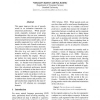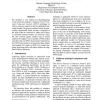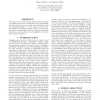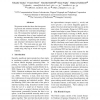122 search results - page 8 / 25 » Sequential Model Selection for Word Sense Disambiguation |
ACL
2010
13 years 5 months ago
2010
This paper improves the use of pseudowords as an evaluation framework for selectional preferences. While pseudowords originally evaluated word sense disambiguation, they are now c...
ACL
2004
13 years 8 months ago
2004
We introduce a new method for disambiguating word senses that exploits a nonlinear Kernel Principal Component Analysis (KPCA) technique to achieve accuracy superior to the best pu...
NAACL
1994
13 years 8 months ago
1994
This paper presents and evaluates models created according to a schema that provides a description of the joint distribution of the values of sense tags and contextual features th...
BMCBI
2010
13 years 7 months ago
2010
Background: Word sense disambiguation (WSD) algorithms attempt to select the proper sense of ambiguous terms in text. Resources like the UMLS provide a reference thesaurus to be u...
EMNLP
2007
13 years 8 months ago
2007
We present results that show that incorporating lexical and structural semantic information is effective for word sense disambiguation. We evaluated the method by using precise in...




